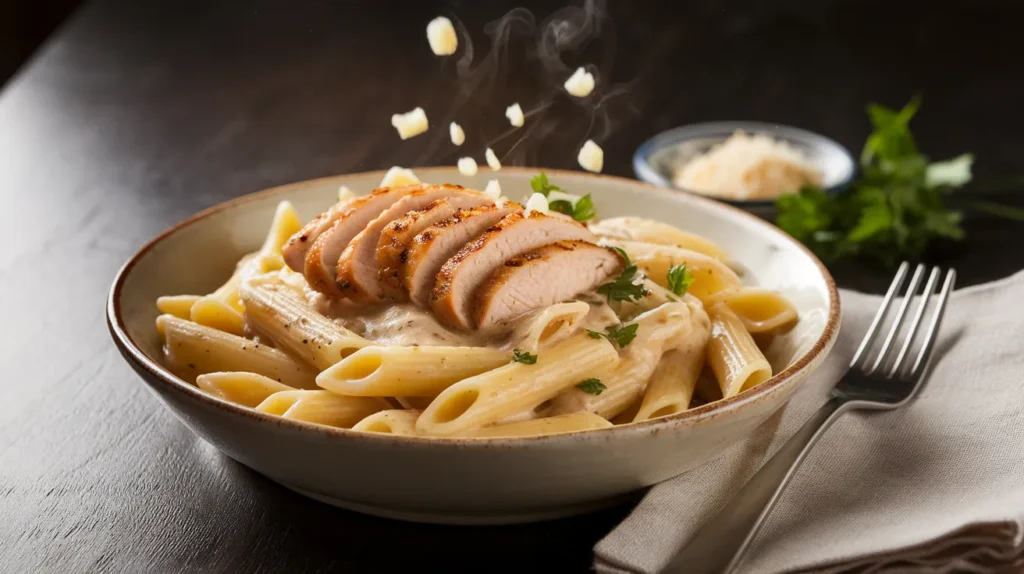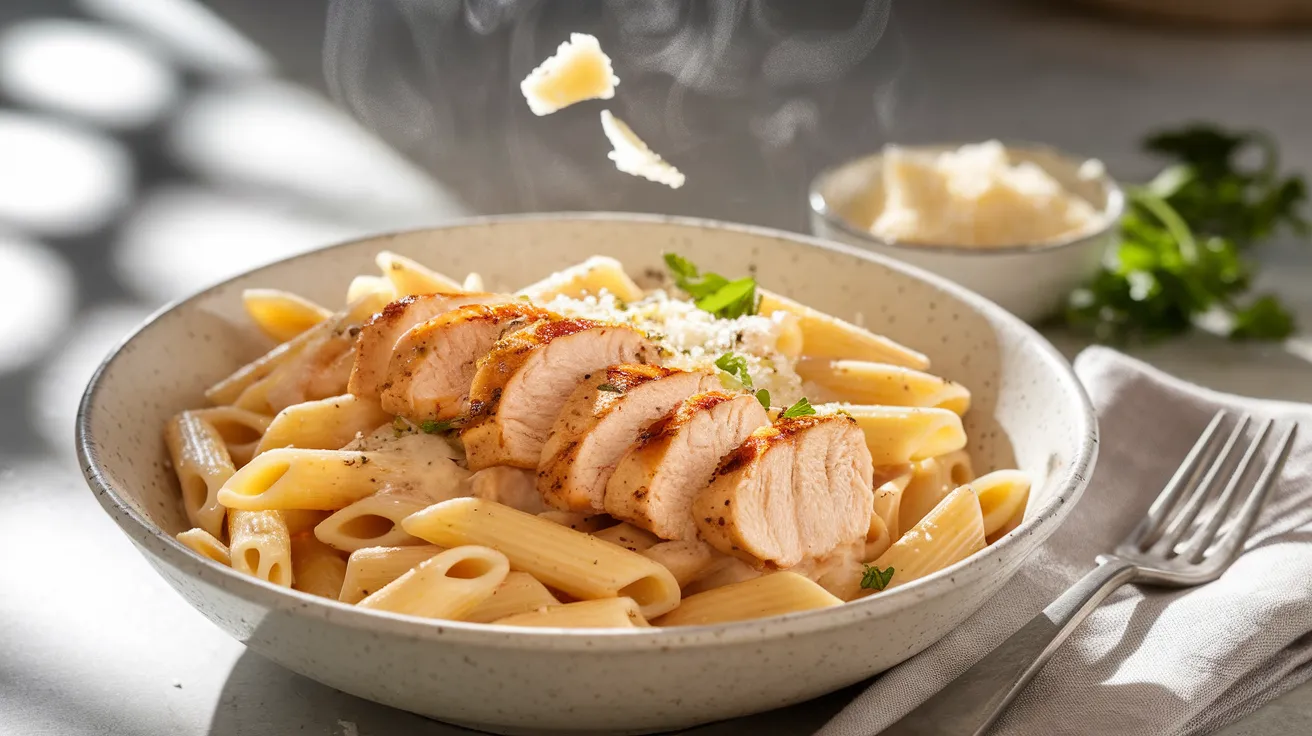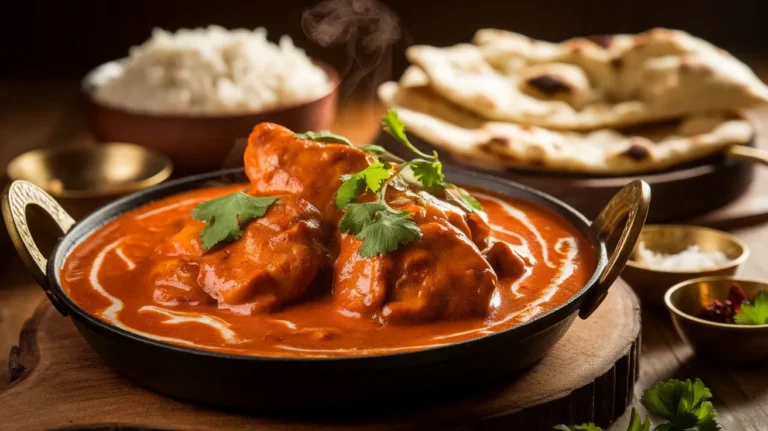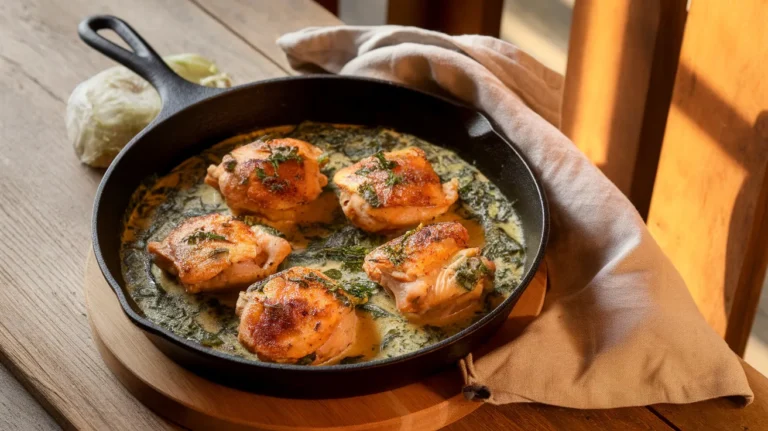Rich, velvety penne chicken alfredo transforms simple ingredients into restaurant-quality comfort food your family will request on repeat. This creamy pasta dish combines tender chicken, perfectly cooked penne, and a homemade alfredo sauce that beats any jarred version—and it’s easier than you think.
SERVES: 4 | PREP: 15 MIN | COOK: 25 MIN | TOTAL: 40 MIN
Why This Penne Chicken Alfredo Works
The secret to knockout penne chicken alfredo isn’t fancy ingredients—it’s the technique. We’re cooking everything in phases so each component reaches perfection. The chicken gets a golden crust, the pasta stays al dente, and the sauce becomes silky without separating.
You’ll use one pan for the chicken and another for the sauce, which means less cleanup than you’d expect. Plus, making alfredo from scratch takes the same time as boiling water for jarred sauce.
Ingredients You’ll Need
For the Chicken
| Ingredient | Measurement |
|---|---|
| Chicken breasts (boneless, skinless) | 1.5 lbs (about 3 medium) |
| Olive oil | 2 tablespoons |
| Salt | 1 teaspoon |
| Black pepper | ½ teaspoon |
| Garlic powder | 1 teaspoon |
| Italian seasoning | 1 teaspoon |
For the Pasta
| Ingredient | Measurement |
|---|---|
| Penne pasta (dried) | 12 oz |
| Salt for pasta water | 2 tablespoons |
For the Alfredo Sauce
| Ingredient | Measurement |
|---|---|
| Butter (unsalted) | 4 tablespoons |
| Heavy cream | 2 cups |
| Garlic cloves (minced) | 4 large |
| Parmesan cheese (freshly grated) | 1½ cups |
| Salt | ½ teaspoon |
| Black pepper | ¼ teaspoon |
| Nutmeg (optional) | Pinch |
For Garnish
| Ingredient | Measurement |
|---|---|
| Fresh parsley (chopped) | 2 tablespoons |
| Extra Parmesan | For serving |
Step-by-Step Instructions
Phase 1: Prep Work (5 Minutes)
Step 1: Fill your largest pot with 4 quarts of water and add 2 tablespoons of salt. Set it on the stove over high heat with the lid on—this helps it boil faster while you prep everything else.
Step 2: Pat the chicken breasts completely dry with paper towels. This step is crucial because wet chicken won’t brown properly, and you’ll miss out on that golden crust that adds flavor. Cut each breast horizontally to create thinner cutlets about ¾-inch thick. Thinner pieces cook faster and more evenly.
Step 3: Season both sides of the chicken with salt, pepper, garlic powder, and Italian seasoning. Press the seasonings into the meat with your fingers so they stick. Let the chicken sit while you gather your other ingredients—this brings it closer to room temperature for even cooking.
Step 4: Mince your garlic cloves and grate your Parmesan cheese. Never use pre-grated Parmesan from a container for this recipe—it contains anti-caking agents that make your sauce grainy instead of smooth.
Phase 2: Cook the Chicken (10 Minutes)
Step 5: Heat 2 tablespoons of olive oil in your largest skillet over medium-high heat. Wait until the oil shimmers and slides easily across the pan—about 2 minutes. Test readiness by flicking a tiny drop of water into the pan; it should sizzle immediately.
Step 6: Carefully lay the chicken pieces in the pan, making sure they don’t touch each other. You might need to work in batches if your pan isn’t big enough. Crowding the pan creates steam instead of a sear, giving you rubbery chicken.
Step 7: Don’t touch the chicken for 5 full minutes. Seriously—resist the urge to peek or flip. You’re building a golden-brown crust that adds incredible flavor. You’ll know it’s ready to flip when the edges turn opaque white about halfway up the side.
Step 8: Flip each piece and cook for another 4-5 minutes on the second side. The internal temperature should reach 165°F on an instant-read thermometer. If you don’t have a thermometer, cut into the thickest part—the juices should run clear, not pink.
Step 9: Transfer the cooked chicken to a clean cutting board and tent it loosely with aluminum foil. Let it rest for 5 minutes while you make the sauce. This resting period allows the juices to redistribute, keeping your chicken moist instead of dry.
Phase 3: Cook the Pasta (10 Minutes)
Step 10: Your water should be boiling by now. Add the penne pasta and stir immediately to prevent sticking. Set a timer for 2 minutes less than the package directions suggest—you want it al dente with a slight bite because it’ll finish cooking in the sauce.
Step 11: While the pasta cooks, place a measuring cup near the stove. Before draining, scoop out 1 cup of the starchy pasta water. This liquid gold helps bind your sauce to the pasta later if needed.
Step 12: Drain the pasta in a colander but don’t rinse it. That starchy coating helps the alfredo sauce cling to every piece.
Phase 4: Make the Alfredo Sauce (8 Minutes)
Step 13: Wipe out your chicken skillet with a paper towel (don’t wash it—those browned bits add flavor). Melt the butter over medium heat until it stops foaming, about 1 minute.
Step 14: Add the minced garlic and cook for 30-45 seconds, stirring constantly. The garlic should smell fragrant but not turn brown—brown garlic tastes bitter and will ruin your sauce. If it starts browning, immediately remove the pan from heat.
Step 15: Pour in the heavy cream and stir to combine with the butter and garlic. Bring the mixture to a gentle simmer—you’ll see small bubbles around the edges but not a rolling boil. This takes about 3 minutes. A hard boil will make the cream separate and look curdled.
Step 16: Reduce the heat to medium-low. Add the Parmesan cheese in three additions, whisking constantly after each addition. Wait until the first batch melts completely before adding more. This gradual method prevents clumping and ensures a smooth sauce.
Step 17: Season the sauce with salt, pepper, and a tiny pinch of nutmeg if you’re using it. The nutmeg adds a subtle warmth that makes people wonder what your secret ingredient is. Taste and adjust—the sauce should be creamy and well-seasoned but not salty.
Step 18: If your sauce seems too thick, add the reserved pasta water 2 tablespoons at a time until it reaches a consistency that coats the back of a spoon. Too thin? Let it simmer for another minute to thicken up.
Phase 5: Combine and Serve (2 Minutes)
Step 19: Slice your rested chicken into ½-inch strips. Cutting on a diagonal makes it look more elegant.
Step 20: Add the drained penne to the alfredo sauce and toss gently with tongs until every piece is coated. The pasta should look glossy and cream-colored.
Step 21: Divide the sauced penne among four plates or bowls. Top each portion with sliced chicken, a sprinkle of fresh parsley, and extra Parmesan cheese. Serve immediately while everything is hot and the sauce is at its creamiest.
Chef’s Notes
Cheese Quality Matters: Block Parmesan that you grate yourself melts into silky perfection for your penne chicken alfredo. Pre-shredded versions contain cellulose (wood pulp) that prevents melting smoothly.
Cream Temperature Trick: Let your heavy cream sit out for 15 minutes before cooking. Room-temperature cream incorporates more smoothly and reduces the risk of the sauce breaking.
Chicken Alternative: Rotisserie chicken works beautifully as a shortcut. Shred 3 cups of meat and warm it in the sauce during the last minute of cooking.
Timing is Everything: Alfredo sauce waits for no one. It thickens as it sits and can become gluey. Serve your penne chicken alfredo the moment it’s ready for the best texture.
Nutrition Information (Per Serving)
| Nutrient | Amount |
|---|---|
| Calories | 820 |
| Protein | 48g |
| Carbohydrates | 65g |
| Fat | 38g |
| Saturated Fat | 22g |
| Fiber | 3g |
| Sodium | 680mg |
Delicious Variations to Try
Cajun Chicken Alfredo: Add 2 tablespoons of Cajun seasoning to your chicken before cooking. The spicy kick contrasts beautifully with the creamy sauce. If you love bold flavors, try our Indian chicken tikka masala for another exciting take on creamy chicken dishes.
Veggie-Loaded Version: Toss in 2 cups of steamed broccoli florets, sautéed mushrooms, or roasted cherry tomatoes during the final toss. The vegetables add color, nutrition, and textural contrast.
Bacon Alfredo: Cook 6 strips of bacon until crispy, crumble them, and sprinkle over the top. Use 2 tablespoons of the bacon fat in place of some butter for extra richness.
Lighter Penne Chicken Alfredo: Replace half the heavy cream with whole milk and reduce the Parmesan to 1 cup. It won’t be quite as decadent, but you’ll save about 200 calories per serving. For another lighter chicken option with bold flavor, check out our red pepper chicken.
Storage & Reheating Guide
Refrigerator Storage: Transfer leftover penne chicken alfredo to an airtight container and refrigerate for up to 3 days. The sauce will thicken considerably as it cools—this is completely normal.
Reheating Method: Place leftovers in a skillet over medium-low heat. Add 2-3 tablespoons of milk or cream and stir gently until warmed through, about 5 minutes. Microwaving works in a pinch but can make the pasta rubbery. If you microwave, use 50% power in 1-minute intervals, stirring between each.
Freezing (Not Recommended): Cream-based sauces don’t freeze well. The sauce will separate when thawed, becoming grainy and watery. Make only what you’ll eat within 3 days.
Meal Prep Tip: Store the cooked chicken and pasta separately from the sauce. Combine and reheat portions as needed to prevent the pasta from absorbing too much sauce.

Troubleshooting Common Problems
Problem 1: Grainy, Separated Sauce Your heat was too high or you added the cheese too quickly. Alfredo sauce needs gentle heat and patience. Fix it by whisking in 2 tablespoons of heavy cream over low heat. For future batches, never let the cream boil hard, and add cheese gradually.
Problem 2: Rubbery, Tough Chicken You overcooked it or cooked it straight from the fridge. Chicken continues cooking after you remove it from heat, so pull it off at 160°F instead of 165°F—carryover cooking will bring it to the safe temperature. Always let chicken sit at room temperature for 10 minutes before cooking.
Problem 3: Sauce Too Thick Alfredo thickens as it cools. Always reserve pasta water and add it back 1 tablespoon at a time while reheating. The starch in pasta water also helps the sauce cling better than plain water or milk.
Problem 4: Bland, Flavorless Pasta You didn’t salt your pasta water enough. Pasta water should taste like the ocean—that 2 tablespoons of salt isn’t negotiable. Under-salted pasta tastes flat no matter how flavorful your sauce is.
Problem 5: Sauce Won’t Stick to Pasta You rinsed the pasta after draining. That starchy coating is what helps sauce adhere. Also, make sure you’re tossing the pasta in the sauce while both are hot—cold pasta repels sauce.
Equipment Essentials
- Large pot (6-quart minimum) for boiling pasta
- Large skillet (12-inch) with high sides for chicken and sauce
- Sharp knife for slicing chicken
- Cutting board (separate for raw chicken)
- Box grater for Parmesan cheese
- Whisk for smooth sauce
- Tongs for tossing pasta
- Measuring cups and spoons
- Instant-read thermometer (highly recommended)
- Colander for draining pasta
Shopping List by Store Section
Dairy Section
- Heavy cream (1 pint)
- Butter, unsalted (1 stick)
- Parmesan cheese block (8 oz)
Meat Department
- Chicken breasts, boneless skinless (1.5 lbs)
Pasta Aisle
- Penne pasta (12 oz box)
Produce Section
- Fresh garlic (1 bulb)
- Fresh parsley (1 bunch)
Spice Aisle
- Italian seasoning
- Garlic powder
- Black pepper
- Nutmeg (optional)
Pantry Basics
- Olive oil
- Salt
Success Secrets from the Pros
1. Temperature Control is King Medium heat is your friend for alfredo sauce. High heat causes the cream to break and the cheese to clump. If you see vigorous bubbling, reduce the heat immediately.
2. Fresh Parmesan Changes Everything Investing in a block of real Parmigiano-Reggiano transforms this dish from good to extraordinary. The flavor is sharper, nuttier, and more complex than domestic Parmesan.
3. Don’t Skip the Chicken Rest Five minutes of resting makes the difference between juicy, tender chicken and dry, stringy meat. Use this time to finish your sauce.
4. Mise en Place Matters Have everything measured and ready before you start cooking. Once you begin the sauce, things move quickly, and you won’t have time to hunt for ingredients.
5. Taste and Adjust Everyone’s saltiness preference differs. Taste your sauce before combining it with the pasta and adjust the seasoning. Remember that Parmesan is naturally salty, so start conservatively with added salt.
This penne chicken alfredo proves that restaurant-quality meals belong in your home kitchen. With proper technique and quality ingredients, you’ll create a dish that rivals any Italian restaurant—and you’ll have dinner on the table in less than an hour.




